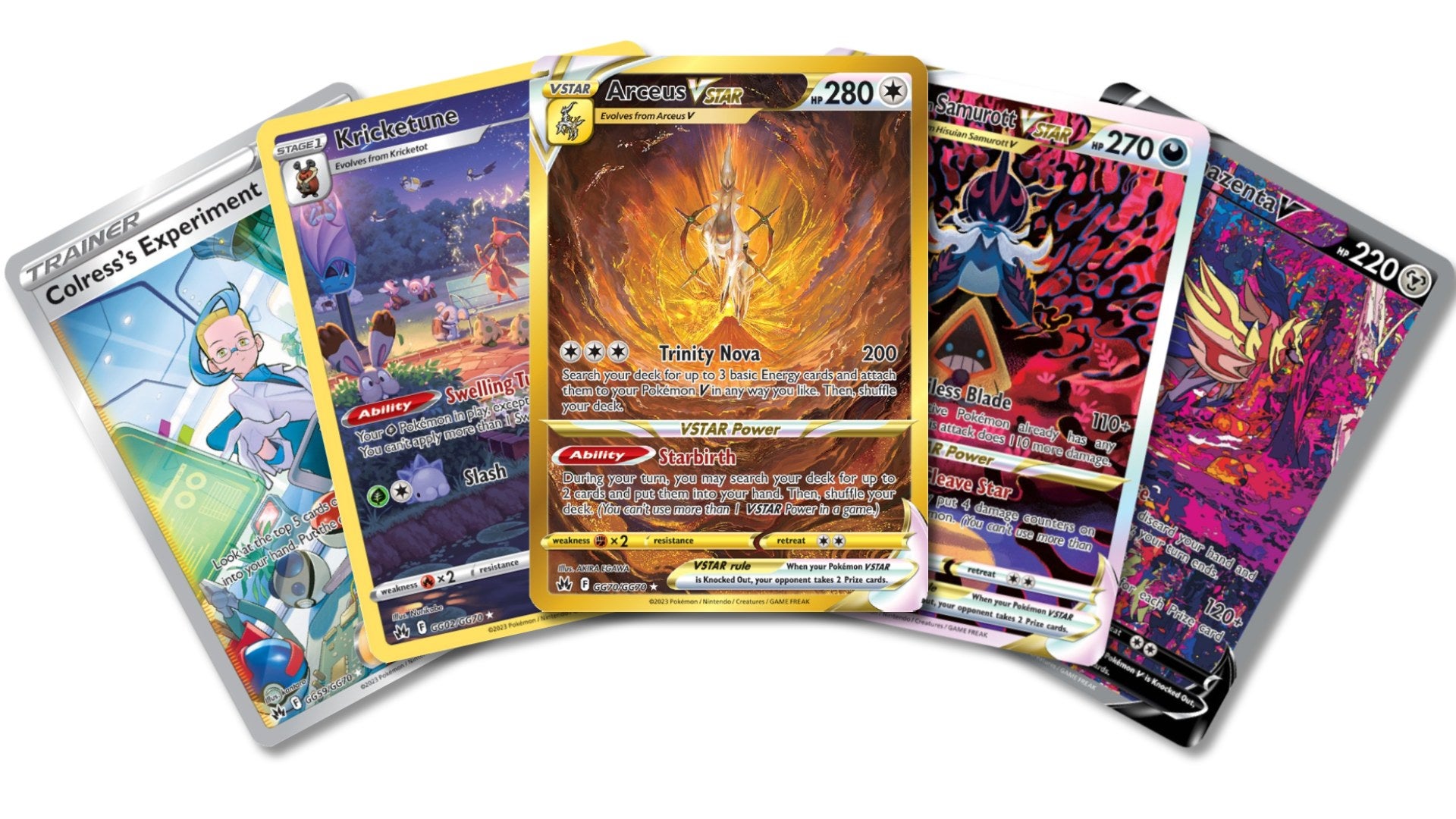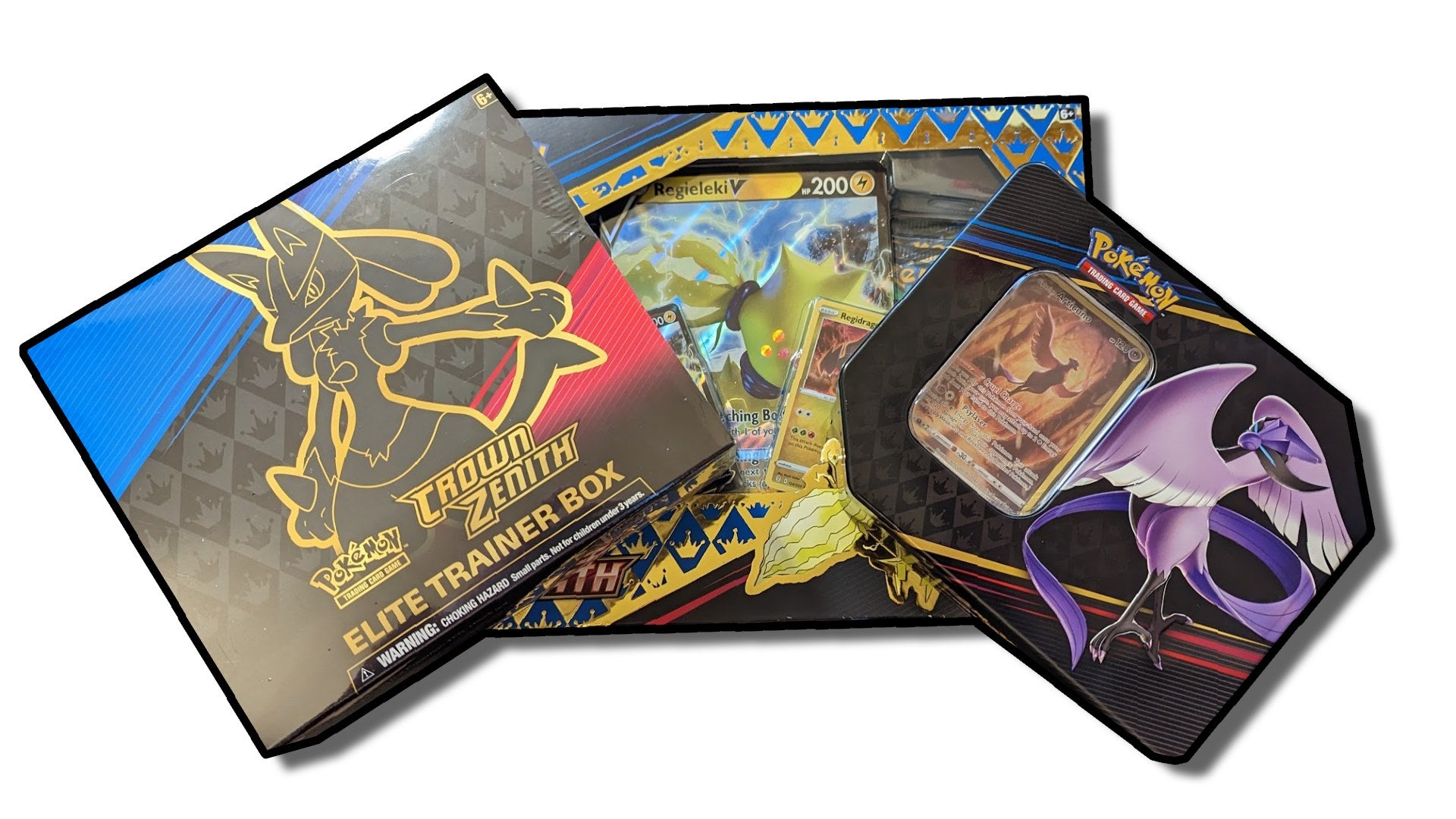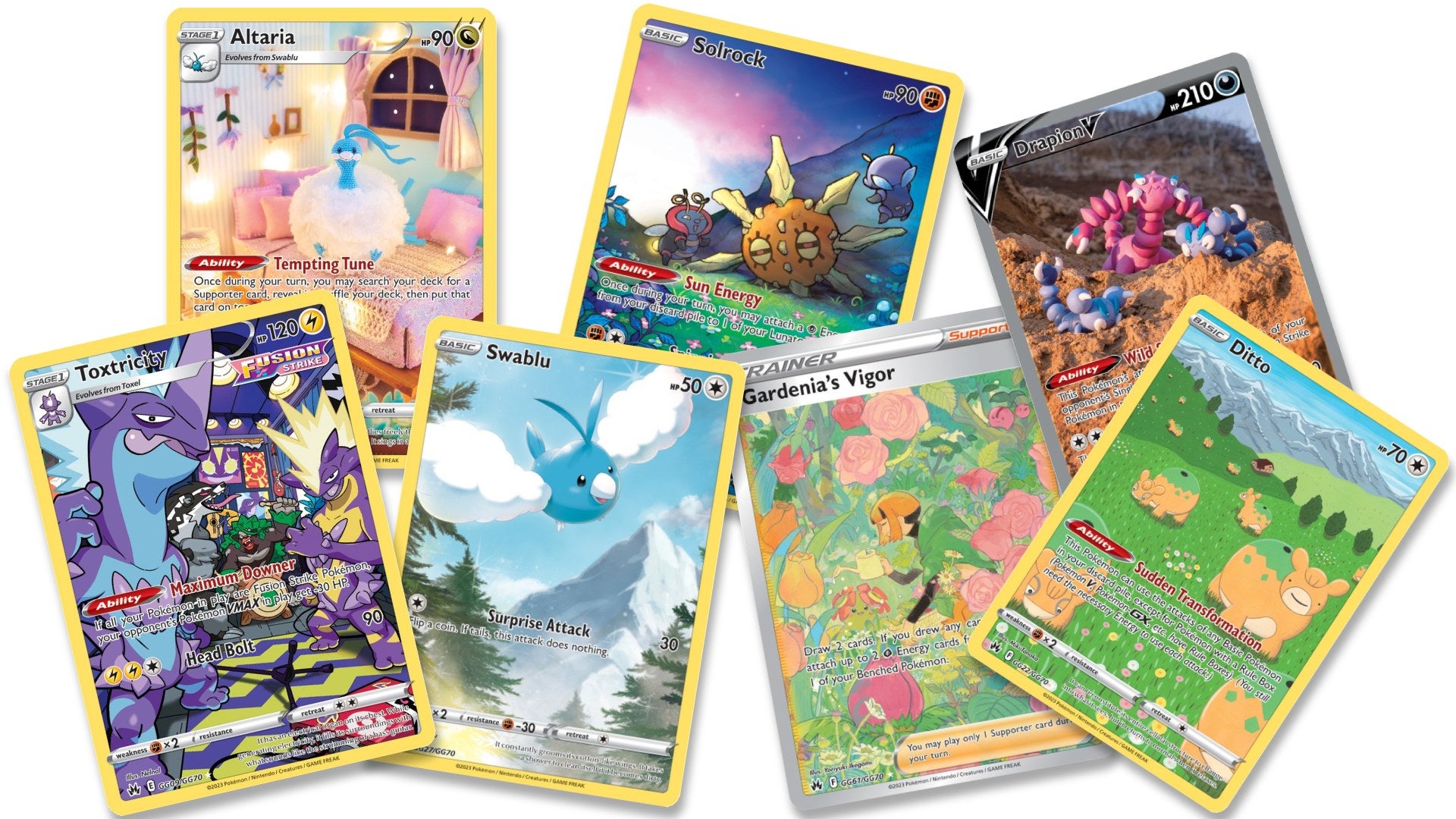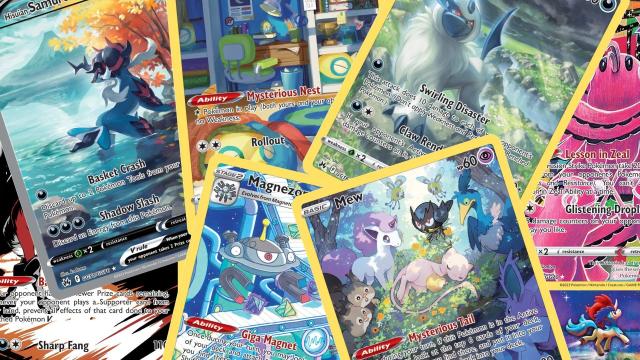It’s the end of an era. Over the last three years, the Pokémon Trading Card Game has been primarily focused on the Pokémon and characters from 2019’s Sword and Shield (SWSH) game, but come March 20, that’s all coming to an end. That’s when the world outside of Japan will see its first official sets of Scarlet & Violet (SV), marking the trading card game’s triennial shift from one game to the next. But Sword & Shield is not going away quietly. Its last hurrah is a set called Crown Zenith, in stores from tomorrow, and we’re calling it: This is the best set the Pokémon TCG has ever seen.
The secret is the sheer volume of full art cards and the frequency with which they look likely to be appearing in packs. While so-called “full art” cards were first introduced to the PTCG back in 2011, via the first Black & White card sets, they have never been so prolific as we’ve seen these last three years. On top of those initial full arts, the intervening Sun & Moon sets introduced Rainbow Rares, reimagined Gold Cards, and right toward the end brought in the “alternate art” cards, where artists could reimagine a card with usually far more elaborate or detailed pictures.
All of these became standard throughout SWSH’s run, and last year saw the possibly permanent addition (following a precursor of the idea since an earlier version in 2019’s Cosmic Eclipse) of the Trainer Gallery — 30-ish card sets within sets, featuring trainers and their Pokémon in beautifully drawn non-battle situations. The result has seen players and collectors more focused on pulling these far more striking cards, with the previously sought-after holos getting relegated to the lower ranks with the rest of the bulk.
The problem throughout all of this has been the “pull rate.” The rarity of these cards, admittedly known as “ultra rares” and “secret rares,” has meant far too often the expensive packs of 10 cards have felt like duds. Not getting — at the very least — a half-art V card, has meant a $US4 ($AU5.78) to $US5 ($AU7.22) pack can feel like money thrown away, just a pile of bulk. Now, of course, there are many qualifying arguments here, especially if you’re looking to build a deck and really need that fourth uncommon Horsea for your Water deck, or what have you. But for collectors, let’s not mess around: it’s all about the ultra rares.
The Pokémon Company International (TPCi) is not stupid. Of course, this is a motivating factor in keeping such cards harder to pull and thus gives people cause to spend vastly more money. It has ever been so, since your great-grandmother collected baseball cards. But it’s perhaps gotten a bit bonkers since Brilliant Stars of February last year, where the 172-card set contained, in fact, 216 different cards — 14 of them secret rares — and 30 in the Trainer Gallery. Of the 216, almost half were ultra rare or above. This hobby got stupid-expensive, even before you’re talking about a PSA 10 alt-art Charizard V from that set. (Let alone Evolving Sky’s infamous Moonbreon.)

Did You Pull?
Step in, Crown Zenith. Essentially the rest-of-world version of the Japanese VSTAR Universe set, this climactic collection of SWSH cards boasts by far the most beautiful cards the PTCG has ever seen, including the 70-card Galarian Gallery of stunning full-art foils. And perhaps more importantly, features them readily.
The Pokémon Company sent Kotaku a few samples of the set, including an Elite Trainer Box, a tin, and a collection box, with a total of 19 packs for us to open ahead of the shelf date. Enough to get a decent idea of pull rates, even if somewhat short of scientific. Combined with watching those Chosen One YouTubers for whom embargoes don’t exist, we’ve been able to get a good impression of the set, and wow, it’s so much better.
Out of the 19 packs my son and I tore open, we scored a total of 18 ultra rares or above, which is an unheard of rate outside of Japan. (And that’s not including those that came with the tin and collection box, just the ones from the packs.) While we missed my chase card, the alt-art Leafeon, we did manage to hit some of the cards we most wanted. As a collector of cards by Asako Ito and Yuka Morii, I was thrilled to get both artists’ full-art contributions, respectively the Altaria and Drapion V. My boy was delighted to get the brand new Zacian VSTAR, a Radiant Eternatus, and the reprint of the Brilliant Stars Charizard V. And we both whooped with joy at pulling the adorable Galarian Gallery Ditto, disguised as a grinning Numel. Oh, and the beautiful GG Swablu! And the brand new Eevee V! Or what about that GG Toxtricity? And the ridiculously lovely Gardenia’s Vigour… In total, we got seven of the Galarian Gallery cards, meaning we were hitting better than one in three packs!
To put this in perspective, for his Christmas present, the kid got a 36-pack booster box of Silver Tempest cards, an astoundingly poor box from a set with — anecdotally — an especially poor pull rate, from which he pulled far, far fewer. This was a very different experience.

Crown Zenith Decoded
I’m loath to celebrate this too much, because honestly, this is how I feel the cards ought to always work. If half your set is made up of such cards, then you should have a much better chance of seeing any of them in a pack than the maybe one-in-five the last few years have seen.
For reasons likely to do with the weight of packs (the texture and extra ink of an ultra rare can make packs weigh a few micrograms more, making it easy for nefarious sorts to otherwise filter out the better packs), for a few years Pokémon card packs have come with “code cards” (cards that have a QR code for the online version of the game) with borders or colours indicative of the quality of the cards within. Get a white border, and you know your pack is likely a dud (albeit with the small chance of getting a Trainer Gallery or Alt Art in the reverse-holo position). It’s incredibly sucky, making a “white code card” the death knell of joy when opening an expensive collection of cardboard.
I don’t know why, but Crown Zenith has done away with this system, and all code cards have a black border, no matter the contents of the pack. (Once they’re released proper, we’ll soon know if they can be weighed.) They also don’t feature holos, and you won’t mind a bit, because they’re replaced by so many more full-art cards. Out of the 19 packs, four contained double-hitters, each with two excellent cards. Again, that’s vastly higher than we’ve seen before.
Crown Zenith Vs The Universe
This seeming generosity all gets a bit tempered when you compare it to the Japanese version, VSTAR Universe. Because, if you’d been hoping to see pull rates as high as that set, then tragically, I have to tell you it’s nothing like it. VSTAR Universe is absolutely bonkers, offering 10-card packs containing as many as four ultra rares or higher, and at the very least, a pile of holos. And I’m very sad to report that the TPCi versions haven’t copied across the absolutely stunning reverse-holo patterning Japan enjoyed, where cards were given a full-card holo effect of glistening bubbles. In Crown Zenith, we’re stuck yet again with the dreary herringbone pattern that’s afflicted SWSH throughout.
In further bad news, while Crown Zenith does feature Energy holos, they’re not the extraordinary patterns we saw in VSTAR Universe. The Japanese set’s special Energy cards have a holo effect that switches from Poké Balls to the Energy type’s symbols as you tilt the cards, which is like nothing the cards have seen before. Why on Earth that wouldn’t be replicated for the international cards is bewildering, and ours are just a plain foil sheen. Boo.

Rebalancing Expectations
Putting aside the disappointment that we weren’t treated to quite the excess seen in Japan, Crown Zenith remains the best set the PTCG has seen. It’s part best-of, featuring reprints of favourite cards from the last few years, and part bumper collection of some of the best art the game has ever seen. While they’ve avoided reprints of the biggest money cards (there’s no Brilliant Stars alt-art Giratina, or Evolving Skies Umbreon, for instance), the set instead focuses far more on giving out the most playable faves, alongside others that are certain to become ludicrously collectible.
This is a fitting finish for the Sword & Shield era, and due to the vastly improved pull rates, really does achieve its intended goal of celebrating the Galar region. Had it been as miserly as we’ve seen in recent sets, it would have felt disastrous, not least when this set isn’t available in booster boxes, making it extra-expensive to buy in bulk. The art is consistently wonderful, and it was quite the experience to open a pile of packs and not come away feeling cheated.
Of course, this does rather rebalance expectations for March’s first sets of Scarlet & Violet. We’ve already been told that prices are going up from $US3.99 ($AU5.76) to $US4.49 ($AU6.49) for booster packs, but this is potentially balanced by each pack being guaranteed to contain at least three foils, and all rares will now be foil. However, it seems unlikely the rates of full art pulls will be the same, which will be a bitter pill after ending SWSH on such a high. Hopefully, the promise of the returning Pokémon-ex mechanic, along with the mysterious possibilities of terastalized Pokémon cards, will be interesting enough that focusing on how it affects live play might distract from this. However, given how many gorgeous art rares are found in the Japanese versions of the sets, there’s cause for hope.

Leave a Reply